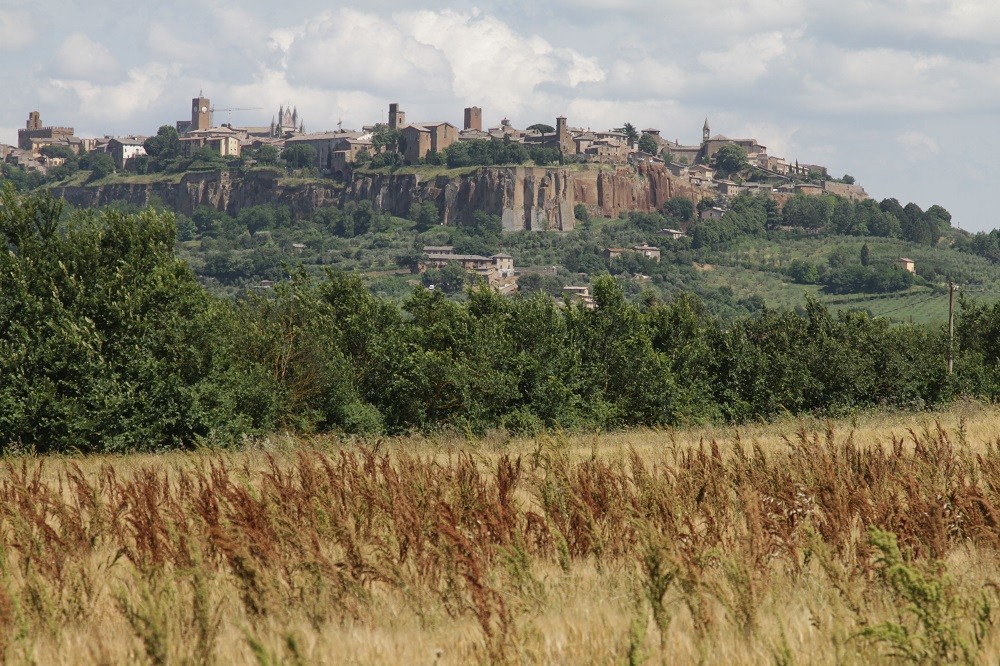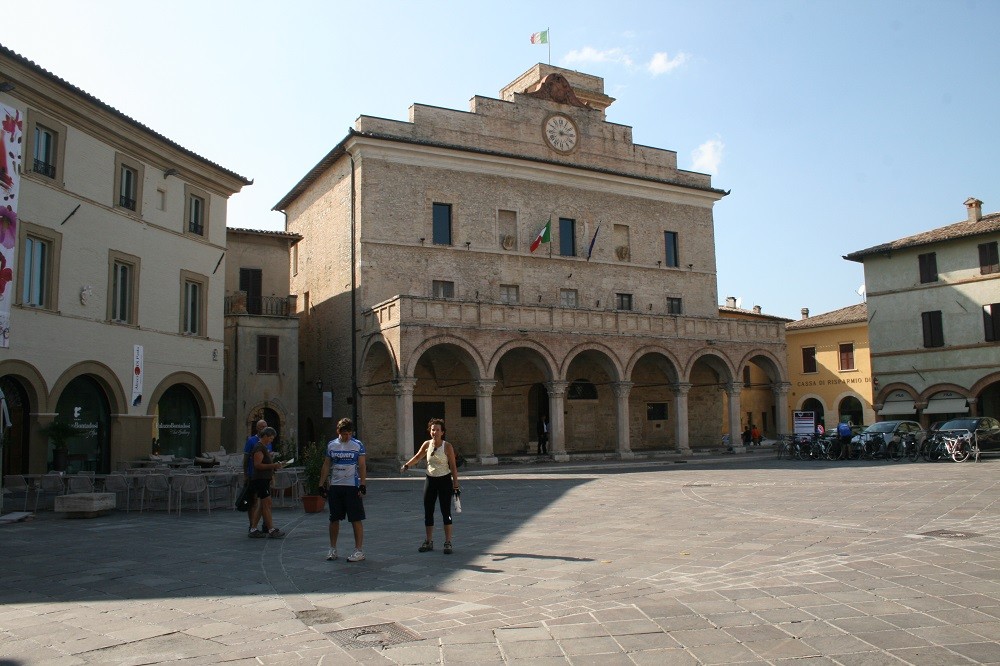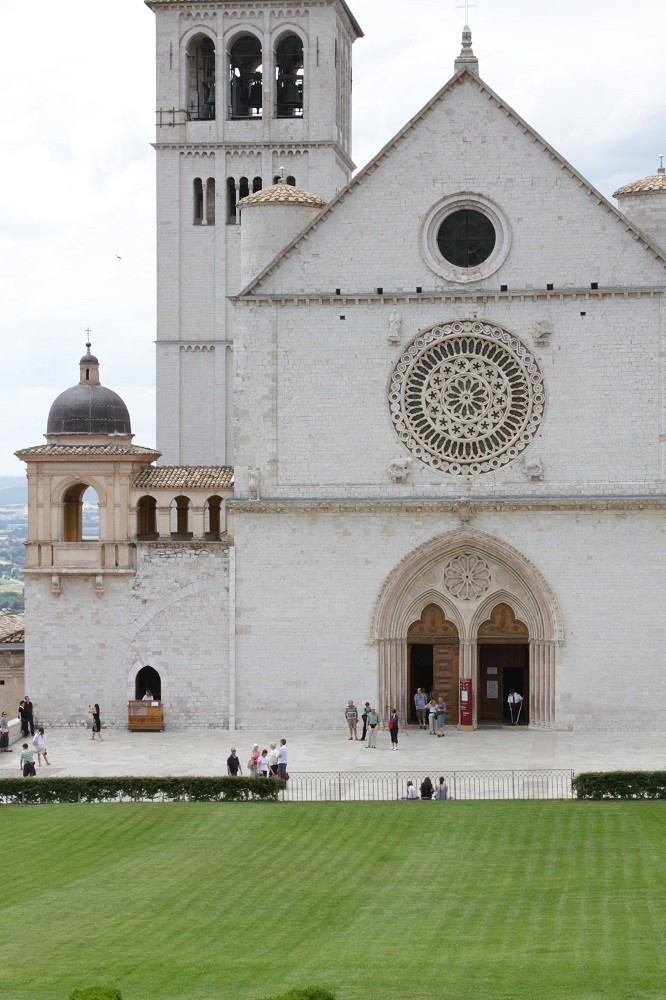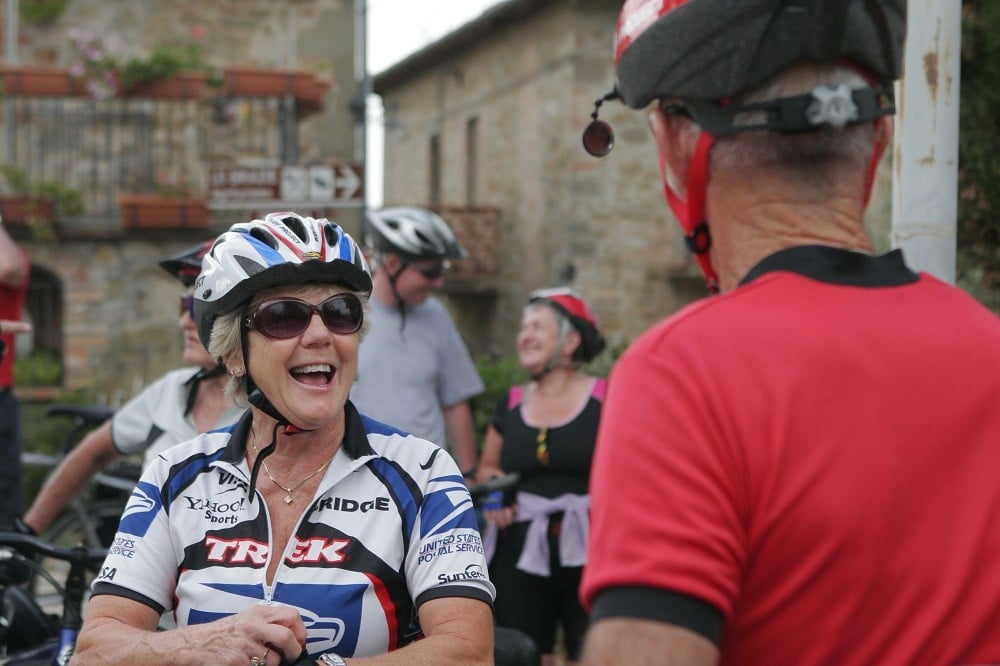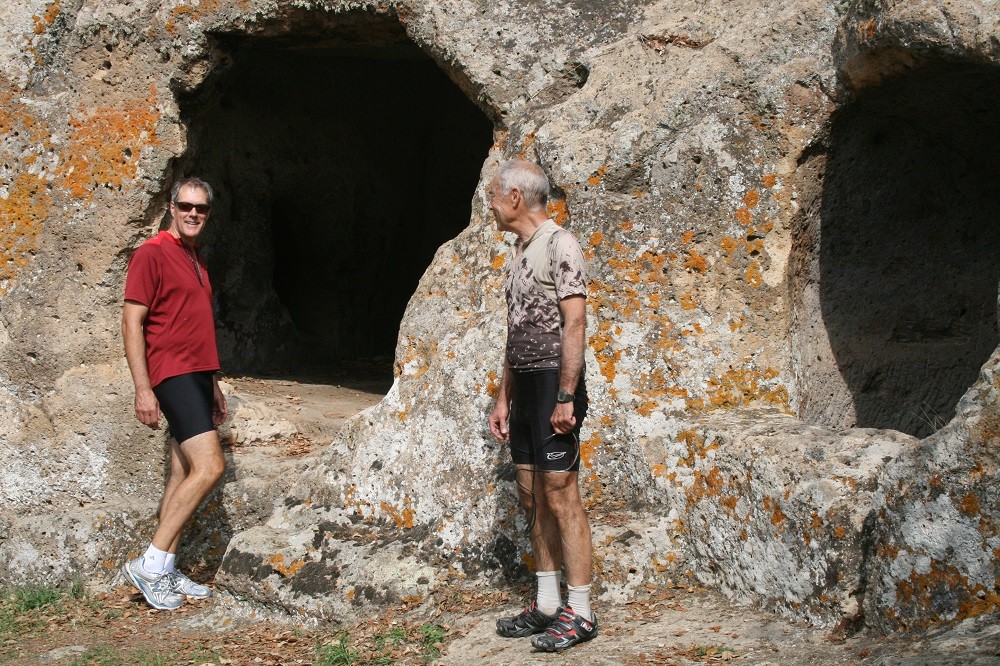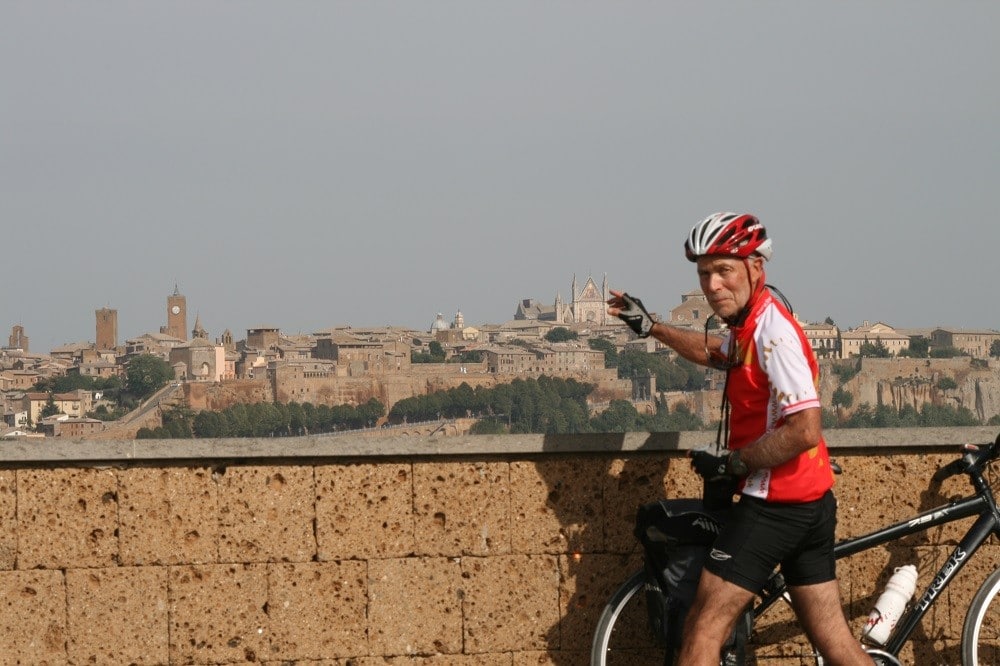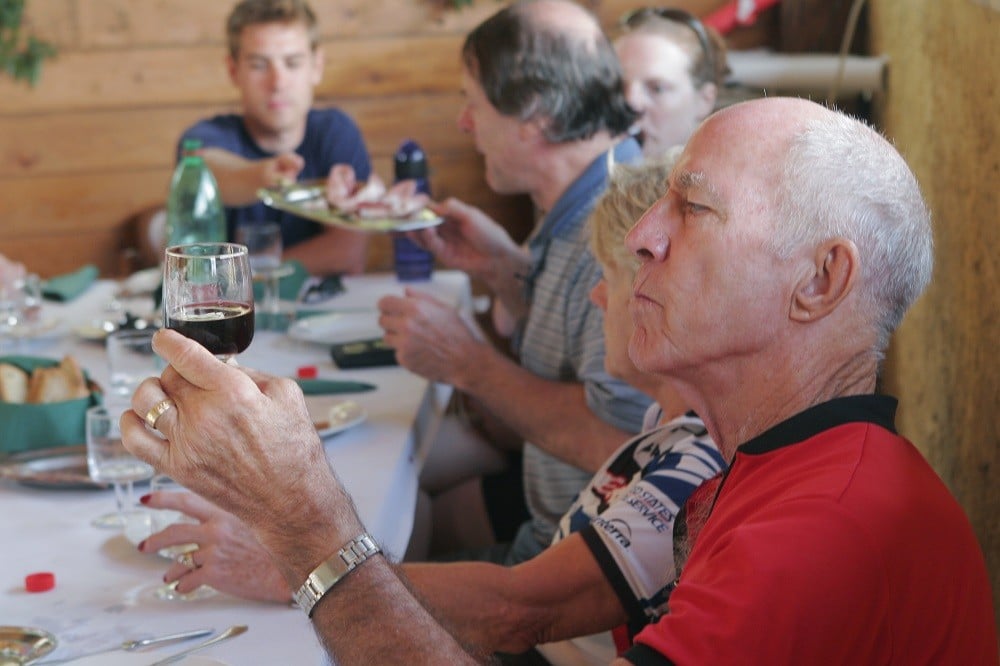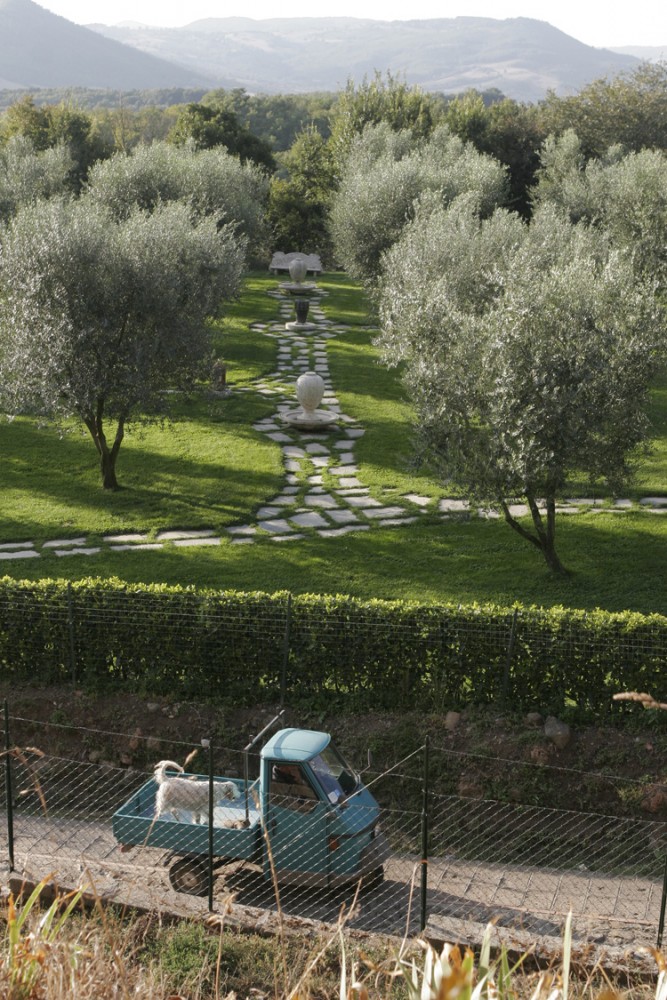What to expect
Umbria is Tuscany's quieter, less-famous neighbour. But a beautiful and amazing place, with a rich history from the Renaissance, the Romans and the Etruscans still visible in its towns and cities.
A feature of Umbria is its hill-top towns. It means a lot of climbing on our bikes, but well-worth the trouble. I cannot imagine anyone ever regretted the climb into Orvieto, Perugia or Montefalco.
Highlights of the week include Orvieto, built on top of a volcanic outcrop and overlooking the Tiber valley 1,000 feet below., and Assisi, home to St Francis, Patron Saint of Italy, and more recently a UNESCO World Heritage site.
A personal favourite for me is Perugia. It's a big city, not usually the cyclists' friend, but as well as the stunning view over the Vale of Spoleto, the layers of history, from the huge Etruscan city walls through the Roman Empire, the Renaissance and the modern day, are clearly visible as you rise through the city on the spectacular 'scala mobili'.
As we make our way from Sovana in the south, up the Tiber Valley and past the Lago di Trasimeno to Cortona, we'll cycle through beautiful countryside, enjoy special Umbrian cuisine, find some surprisingly good Umbria wines, and we'll learn that Umbria deserves to be much more than Tuscany's quiet neighbour.
FROM
- Single Room Supplement: +£410
- Transfer from Train Station +£75
- Airport Transfer: N/A
- Self-Drive: N/A
- Available Dates 2024:
September 14-21

ITINERARY
Day 1 Umbria - Home of Saints and Gourmet Food
We don't actually start our Umbria cycling tour in Umbria at all, but deep in southern Tuscany on the border with Umbria. To the west of Orvieto are three beautiful little towns in the Maremma region. Sorano, Sovana and Pitigliano are three little jewels, all dating back to Etruscan times, that lie far enough from Siena and from Rome to be off the tourist route.
They were all deeply involved in the usual fighting of renaissance Italy, passing successively from the powerful Aldobrandeschi family, then to Siena, followed by the Orsini family, and inevitably the Medici.
All three towns are built on the outcrops of extinct volcanoes, although Sovano is low-lying while both Sorano and Pitigliano soar high above their river valleys on high cliffs, so precariously perched that some parts of Sorano have been declared terminally uninhabitable.
We meet at Orvieto by 4.00 pm for the drive to Sovano, where we stay at the Scilla Hotel in the centre of this beautiful town. Tonight is a feast of gourmet food. Every night in Umbria the food is delicious.
Day 2 Three Etruscan Jewels
The first day of our Italian cycling tour takes us on a circular trip that visits both Sorano and Pitigliani, before returning back to Sovana.
Sovana is a tiny town these days, with barely 120 inhabitants. Many of the roads approaching the town follow the traditional sunken roads of the Etruscans, and the famous Etruscan tombs are in evidence everywhere.
Despite it's tiny size, Sovana was once the capital of the Aldobrandeschi family that were said to own a castle for every day of the year. It's heyday was in the 11th century with the accession to the Papal throne of Gregory VII. His house is now a museum - of snails, believe it or not. At one end of the town is a fortress dating from the Aldobrandeschi period. At the other end of the town is a large cathedral, or Duomo. In between is an exquisite town with a beautifully proportioned square of fishbone-patterned bricks laid by the Medicis in the 16th century.
We'll start off by heading to Pitigliano, the largest of the three towns, and the most spectacular. Pitigliano was once a thriving Jewish centre, complete with Jewish University. The Medici put paid to that in the 17th century, confining all Jews to a ghetto within the town. The ghetto is still there, and is open to visitors. It's an interesting place, but horrible. Definitely worth visiting.
Before we get there, we'll pass through our first vineyards. The main wine in these parts is the Bianco di Pitigliano, a gentle, neutral wine which at is best is compared to the better known whites of Orvieto. The best way to explore these wines is at the co-operative of Cantina di Pitigliano, where they produce and store wines in caves cut deep into the Tufa cliffs below the town. As well as the Bianco di Pitigliano, they produce DOC Sovano and a Vin Santo. During our week in Umbria we will explore wines that are almost unknown outside their region, and we can start right here with a wine tasting in Pitigliano.
After lunch we'll bike the 6 miles to Sorano, built on a cliff surrounded by steep valleys and cliffs. Our first chance to enjoy a gelato, and we'll see lots of ancient Etruscan tombs dug into the spectacular cliffs surrounding Sorano.
From Sorano we'll return to Sovano, and a chance to visit famous Etruscan tombs and sunken roads before we spend another wonderful evening in this beautiful little town.
Day 3 Orvieto - Spectacular - and a Long Climb
Into Umbria proper. Our destination today is Orvieto. At the risk of over-using superlatives, Orvieto is spectacular, built on top of a volcanic plug rising more than 300 metres above the surrounding plain. The bad news is that at the end of the day we have to cycle up there.
We leave Sorano on small roads several miles to the north of Lago di Balseno. Sadly, when you're a few miles away from a lake in Umbria, chances are you're in the hills, and today that's certainly true. We've tried to find a balance between finding a pleasant flat route, but avoiding the traffic on the main roads. I remember someone saying to me "No hills means no views". Well, we get some great views today! Nothing too frightening, but we'll have earned our dinner tonight.
Passing through Onano and Acquapendente, we travel cross-country through Castel Viscardo before we get our first view of Orvieto. The view of the Duomo rising from the top of this volcanic plateau is beautiful. We've a 3- kilometre climb to the top of Orvieto, where we stay right in the centre at the 3*** Hotel Duomo. Close-up, the Duomo is even more impressive, described by Jacob Burckhardt as 'the greatest and richest polychrome monument in the world'. It dominates the piazza with it's wonderful black and white stripes. It is an amazing building, a real joy. The whole piazza and the area around it has a lovely atmosphere, perfect to enjoy a well-earned beer.
Almost rivalling the Duomo is fascinating underground Orvieto. More than 1200 caves have been discovered so far, many dating back to the Etruscans. There's also St Patrick's Well, a 60-metre deep well built on the orders of Pope Clement VII following the fall of Rome. The well is 13 metres wide, wide enough to accommodate a double-helix staircase much like Leonardo DaVinci's staircase at Chambord in the Loire Valley. Water was carried up these staircases by teams of mules. More than seventy windows provide light and ventilation, and just above water level a bridge crosses from one side to the other. We'll find the time to visit either on Monday afternoon or on Tuesday morning. 27 miles / 44 Km
Day 4 Wine Tasting Umbria's Best Known Wine - Orvieto Classico
Today we're off deep into the countryside of Umbria. We do get to cycle alongside a lake at last, but I'm afraid we get our fair share of hills as well.
Leaving Orvieto along fairly busy roads, we take the first opportunity to cross the river Paglia, then following it downstream on a lovely quiet road to its confluence with the Tiber. Our route takes us alongside Lake Corbara, through the village of Corbara itself and then we turn away from the lake and into hills. Into wine country. This is the area where many of the best of the Orvieto Classico are made, and we'll stop off for a tasting at Barbereni-Vallesanta in Cerreto.
Our afternoon follows back roads to rejoin the Tiber and climb into Todi, yet another beautiful Italian renaissance city which claims to have Italy's 'most beautifully proportioned renaissance piazza'. I haven't seen them all, but this one is pretty special.
We stay at the Hotel Fonte Cesia in the heart of Todi.
Day 5 Downhill - Much Easier Day - and two Fabulous Wine Tastings
We descend from Todi, crossing the Tiber, and head across the Vale of Spoleto toward Montefalco.
We're on our way to a wonderful vineyard, Cantina Peppucci. We'll taste some wonderful wines before cycling into Bastardo for lunch.
After lunch we cycle to Montefalco, with the inevitable climb to the piazza in the town centre. Montefalco is known as the 'Balcony of Umbria' It has spectacular views in all directions across the Tiber valley, boasts a beautiful circular piazza, and produces some interesting wines.
Foremost among them are the wines of the DOCG Montefalco Sagrantino, made from Sagrantino grapes grown only around Montefalco. These are some of the most powerful and distinguished reds in all of Italy. The name is derived from sagra, the Italian for feast.
This was originally a wine reserved for feasts and festivals, but more is produced now and it is more widely available. Of course we'll take the opportunity to try it out, courtesy of Arnoldo Caprai-Val di Maggio. They also produce Montefalco wines (DOC and Colli Martani Grechetto, but the point is the Sagrantino.
Leaving Montefalco, we cycle along the bottom of the Vale of Spoleto - we've earned a flat ride - to the walled town of Bevagna, where we stay at the 3*** Hotel Brunamonti. Today is our longest bike ride yet, but a fascinating and beautiful trip.
Day 6 Visiting Assisi
Today is perhaps the most spectacular day of our week. We end today in Perugia, the capital of Umbria, and by far its largest city. Before then we visit Assisi.
Assisi was the home of St Francis, the Patron Saint of Italy, and the most important religious figure to have come out of Italy. To enjoy Assisi, it's worth knowing a little bit about St Francis, how important he was, and why. As a youth he was involved, inevitably, in one of the interminable wars between Assisi and Perugia, and spent some time in a Perugian prison following his capture. One chronicler said at the time that he was '…the first instigator of evil, and behind none in foolishness.'
He went on to became an immensely significant religious figure, dominating even the Papacy during his life. His faith was based on poverty, plus the usual trappings of chastity and obedience. His great innovation was the glorification of God through the wonders of the natural world, summed up best in his beautiful 'Canticle To The Sun'. Living a solitary life in Lazio, he invited local shepherds to worship with him at Christmas. They arrived to find that Francis had set up a scene complete with crib and local cows and sheep. This was the first ever Christmas crib - they all derive from St Francis.
He also established a women's order, the Poor Clares, but died aged only 44. The Basilica at Assisi now houses his remains, and therein lies a story.
The Basilica is enormous. From below, Assisi looks like a scene from The Lord of The Rings. It consists, literally, of two cathedrals, built one on top of the other, and having arranged to place the body in the completed Basilica, the Franciscans arranged that Papal troops accompanied the body to deter Perugia from snatching Assisi's emblematic figurehead.
Arriving at the Basilica, the head of the Order asked permission to enter the church alone, and promptly locked the door and disappeared for hours. The body of St Francis had been hidden, again as a safeguard against Perugia, and it stayed hidden until improved technology led to its discovery only in the 19th Century.
The monks at the Basilica are quite serious. Short trousers and short-sleeves are frowned upon, and silence is maintained, but it's an amazing place.
Assisi's great enemy, Perugia, lies only 20 Km away. This is a spectacular city built on steep hillsides. The centre of the city is a bustle of shops, restaurants and bars with the inevitable Duomo, huge town hall and ornamental fountain. Perugia is a busy and thriving City, and it's impossible to get there without cycling on some slightly busier roads.
We take the best route in that we can, cycling mostly along flat roads in the Vale of Spoleto, and then the stiff climb into Perugia. We have a spectacular entrance into the centre of Perugia, ending up at the Hotel Fortuna, close to the centre. My description won't prepare you for the dramatic location of Perugia's centre.
Day 7 In the Footsteps of Hannibal's Elephants
Once again we're deep in the Umbrian countryside, passing to the north of Lake Trasimeno, Italy's largest inland lake, and back into Tuscany, ending our bike tour of Umbria in the beautiful town of Cortona.
It was from Cortona that the Roman General Flaminus led his army to disastrous defeat against Hannibal and his solitary elephant. Between Lake Trasimeno and the hills around it is a narrow plain. Hannibal had gambled that Flaminus would send ahead a vanguard, with the body of the Roman army following behind in their familiar and hitherto invincible formations.
At Passignano the flat plain becomes a narrow gap, and as planned Flaminus' vanguard was able to see the rearb of Hannibal's army just disappearing over the top of the slope. Later, as the main body of the army passed, Hannibal's troops descended onto the Roamns from the surrounding hills. When the vanguard returned several hours later, having pursued and skirmished with a handful of Carthaginians, they found 15,000 dead Romans.
This significant event very nearly became even more significant. Hannibal anticipated that the subject states of central Italy, the Umbrians and the Tuscans, could be encouraged to rise against the Romans. He released all non-Roman prisoners and set off down the Vale of Spoleto (which was then a lake) toward the city of Spoleto. Here, surprisingly, the city of Spoleto stood against Hannibal, winning Rome the time to organise and to strengthen their resources. This all took place 200 years BC - and how different it might all have been.
Leaving Trasimeno behind us we approach the ancient Etruscan town of Cortona, cycling the last five kilometres through vineyards and olive groves. Anyone who has read Frances Mayes 'Bella Tuscany' will be familiar with Cortona, and it doesn't disappoint. It's a beautiful little town, with steep narrow roads, fantastic restaurants and commanding views across the Val di Chiana toward Montepulciano. We stay at the Hotel Oasi Neumann, a converted convent just outside the medieval centre.
Day 8 A well-earned rest from the saddle, and away to pastures new!
I'm afraid it's all over. Transfers to the train station at Camucia-Cortona for transport connections back to London, the USA, Australia and everywhere else.
JOINING DETAILS
Please take careful note of the train times. Our transfers are scheduled to meet these designated trains; if these train times are inconvenient, please contact us so that we can be sure of arranging appropriate transfers.
Quick links

